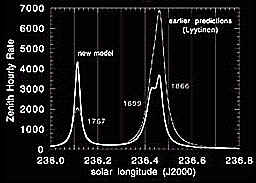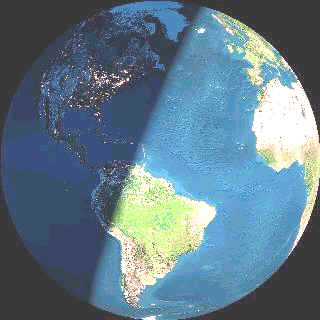 CBA
Belgium Observatory
CBA
Belgium ObservatoryOur Leonids 2001 Expedition to Flagstaff, AZ
 CBA
Belgium Observatory
CBA
Belgium Observatory
Our Leonids 2001 Expedition to Flagstaff, AZ
|
Click here to read about the results of our expedition ! |
||
|
Every 33 years, comet 55P/Temple-Tuttle returns to the inner solar system and releases material that forms into a new dust trail. These debris, when hit by the Earth, produce the Leonid meteors, named after the constellation Leo from which they seem to originate. In most years, the Earth passes far away from the comet's dust trail, and the number of Leonids seen is moderate to low. But, on those rare occasions that the Earth passes through the center of the comet's trail, this results in the most spectacular meteor displays. Almost every 33 years, the Leonids turn into a real meteor storm, producing several thousands of meteors during a couple of hours. Meteor scientists predict that around November 18, 2001 the Earth will pass near the trails released during the 1699, 1767 and 1866 returns of comet 55P/Temple-Tuttle, i.e. 9 revolutions, 7 revolutions and 4 revolutions of the comet ago. A real meteor storm with possible rates of 2500 meteors per hour up to 15000 meteors per hour is expected. |
|
|
| When my astronomical activities started to
develop, the Leonids were the first meteor shower that I ever observed,
back in 1974. The next 10 years, I spent lots of efforts making visual and
photographic observations of meteors. In the early 80's, I joined the VVS
(Belgian Astronomical Society) Meteor Section and
formed a European Photographic Meteor Network for simultaneous observations. We
spent heroic times observing from atop the platform of famous Jungfraujoch
Observatory (Swiss), where we witnessed the first Perseid meteor 'storm' of
the mid 80's.
In November 1999, a quarter of a century after I had first seen Leonids, I was among the lucky Europeans to witness for about half an hour or so, a very spectacular Leonids display, with at least one Leonid meteor appearing every second. Most will call this already a 'storm', although I would prefer to reserve this classification for even higher rates of meteors. But, without any doubt, the 1999 show was already most attractive ! |
|
| Predictions for 2001 |
|
|
Predicting a meteor shower's activity (both the time of
maximum and the intensity level) has been considered virtually impossible
for many centuries. It was only in 1999, that a few mathematical models
were introduced which successfully predicted the date and times the Leonid
meteor stream would reach maximum hourly rates. These models are based on
the shape and the particle distribution within the various streams of
debris left behind by a comet. Although the time of peak rates can be
reasonably well predicted, these models fail to
adequately predict the intensity of the displays. In fact, they are still
very much evolving and (hopefully) improving year after year.
There's only a handful of meteor scientists that have specialized in predicting meteor shower's activities. For sure, David Asher (Armagh Observatory, Ireland) and Rob McNaught (Australian National University & Siding Spring Observatory) are amongst the most famous ones, because they were successful in predicting the 1999 Leonid storm. But, there's several other astronomers whose predictions are quite accurate and interesting to take into account when compiling your plans for observing the Leonids in 2001. |
The predictions for the November 2001 return of
the Leonids have one thing in common, that is they indicate at least one
and likely two peaks in excess of 1000 meteors per hour. Let's briefly
review those predictions :
|
|
| To summarize, the first three predictions favor a maximum activity around 18h UT on November 18, 2001. This puts the area of visibility for a Leonid meteor storm in the western Pacific Ocean, eastern Asia (Japan, Korea, China) and western Australia. The model of Jenniskens predicts maximum activity around 10h UT on November 18, meaning that the United States and Canada are amongst the favored locations on Earth to observe the event. |

(c) Armagh Observatory, College Hill, Northern Ireland |
The figure at left is based on the famous "dust-trail-theory" of David
Asher and Rob McNaught, that correctly predicted the peak of the 1999
Leonid storm to within six minutes. The figure shows the conditions for the 2001 Leonid activity and indicates how the Earth will move through the Leonid dust clouds, and will pass the 1767 dust trail around 10h UT on November 18. About 8 hours later, the Earth will pass the 1699 and 1866 dust trails, producing the combined display that is visible from eastern Asia and western Australia. Interesting to note is that the 1767 dust trail probably also give rise to a brief Leonid meteor storm in 1869, that was observed from the island of Mauritius.
|
| Below is another famous figure, this time based on the models of Lyytinen and Van Flandern, showing the expected ZHR (Zenithal Hourly Rate) on November 18. The event at 10h UT is expected to produce about 2000 meteors per hour, while the combined trails of 18h UT will produce over 7000 meteors per hour. Colors indicate the 'revolutions', e.g. 'red' means debris from 4 revolutions ago. Again, the figure illustrates that no relevant Leonid activity is going to be visible from Europe. |
|
(c) Latest
Leonid 2001 prediction graphics by Mr. Esko Lyytinen & |
| Preparing Our 2001 Expedition | |
| There's two stimuli that finally made me decide
to go and observe the possible Leonid meteor storm of 2001. The first was
a visit of two experienced meteor observers and long-time friends of mine,
Jean-Marie Biets (VVS Belgium Meteor Section) and Hans Betlem (Dutch
Meteor Society DMS) in preparation of their August 2001 Perseid observing
campaign, that they were going to conduct from my backyard. Discussing the
Leonid circumstances of 2001, Hans pointed me to the predictions of Peter
Jenniskens, and told me about his expedition to New Mexico to observe the
event.
The second trigger came in September 2001, while I was flying back on a professional trip from Sweden to Brussels. I was reading the Sky and Telescope article about the Leonids 2001 by Joe Rao (November 2001 issue), and it really convinced me it would be worth spending the effort to fly away from Europe to possibly witness a unique meteor display. I spent a couple of days studying numerous articles, web sites and
Internet discussion groups, and decided that eastern Asia or western
Australia would be the best locations to travel to. Since I was not convinced
about the observing conditions in Australia (altitude of the radiant,
twilight risk), I started to zoom in on China, Korea and
Japan. Weather conditions in Japan, but also in Korea, were not very favorable, so the only destination left was China. I made contacts with a
colleague of mine, working for the same company as I am, but living in
China. I explained my intentions to fly to Beijing and hire a car to
travel to a remote location. He strongly advised against, saying that it
would be very difficult, if not impossible, to travel in a secure way
through China without mastering the local language. |
|
 (c) Peter Jenniskens, NASA. Predicted variation of Leonid shower activity in the model by Jenniskens (thick line) as compared to the model by Lyytinen and Van Flandern (thin line). |
|
I revisited the articles and websites, this
time looking for arguments pro and against Peter Jenniskens' theory, that
puts peak activity over the United States and Canada. There was nothing
conclusive, as one might expect. So, I decided to take the risk and
started preparations for a visit to the US. I assumed that Arizona or New
Mexico would have best chances on clear skies.
There was one obvious way for me to learn about most favorable locations in those two states, and that was to ask my friends from the Center for Backyard Astrophysics (CBA). I sent out an email to their mailing list, and within hours I got an amazing number of very enthusiastic and useful replies. Several people offered me to stay at their premises and to observe the Leonids together with them. |
|
I finally decided to travel to Flagstaff, Arizona because of the fine
climatological conditions, and - more in particular - because of the
opportunity to stay at Braeside Observatory, with my
friend Bob Fried. Bob is a retired pilot, and he owns a Cessna
airplane, allowing us to be extremely mobile in case of bad weather around
Flagstaff.
On November 18th, at 10h UT - i.e. at the moment that the Earth encounters the 1767 dust trail, it will be after midnight at Arizona. The figure at right shows that morning twilight is approaching the US East Coast at that time, whilest the West Coast is still enjoying dark night skies. Even with a slight error in the time of peak activity, chances on observing the spectacle from Arizona are still quite high. |
 |
|
(c) John Walker. Satellite data provided by The Living Earth, Inc. |
| Observing the Leonids from Flagstaff, AZ | |
| Braeside Observatory is a privately operated
astronomical research facility located five miles West of downtown
Flagstaff, Arizona at 7461 feet above sea level. It was founded in 1976 by
Robert Fried, now a retired Delta Airline Captain. The facilities are on a
10 acre tract of land surrounded by State and Federal Forest Land. They
include the telescope building and the control building.
The telescope building houses a fork mounted 16" Cassegrain reflector with an f3.9 primary, that is 100% remotely controlled by computers from the control building. The telescope is mounted on a 30 foot high pier rising some twenty four feet above the ground. The actual observing floor is 20 feet above ground. The dome is an aluminum 14 foot diameter structure, rotated by means of a "drive" ring. A hand railed catwalk surrounds the dome affording safety when removing snow, or just showing the night sky to visitors. A steel stairway leads both to the telescope room and this catwalk. The "Control Building" is located some 100 feet north of the
telescope building, and is pretty much the nerve center of the
observatory. Besides the telescope control room itself, there is a
library/office, a dark room, a snack bar area, blackout sleeping room and
full bath, machine shop, etc. |
|
 The sky above Flagstaff at peak activity (Nov 18, 2001 - 10h UT) |
I will be visiting Braeside Observatory from November 15th
till November 18th. Apart from some local sight seeing (Grand Canyon
National Park, Meteor Crater, some local observatories), my main 'target'
of course are the Leonids.
I will make visual observations only, with the objective of accurately determining ZHR levels over the course of the nights. The sky map at left shows the night sky above Flagstaff, AZ at the moment of peak activity of the Leonids, on November 18th 2001 at 10h UT in the morning. The position of the radiant is indicated with the blue spot. It is at about 45 degrees altitude, a very comfortable position to observe the display. |
|
|